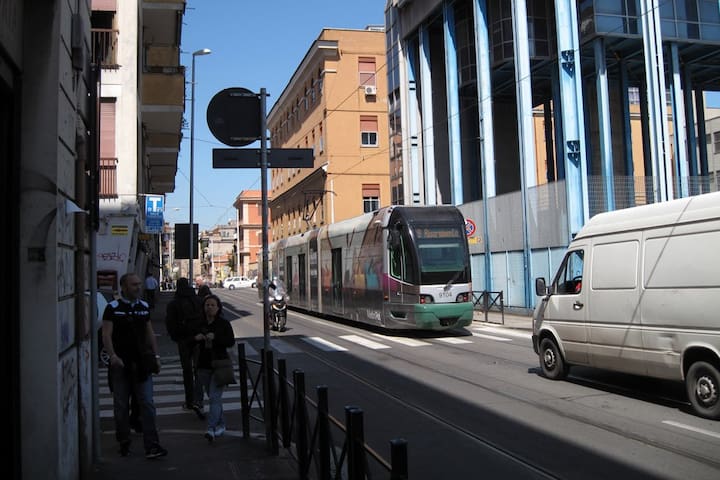Visite turistiche
Tram pubblico a 20 mt dagli appartamenti: ( near 20 mt to the residence)
- n. 19 per vaticano ( to Vaticano)
-n.3 per colosseo ( to Colosseo9
Via dei Reti
Via dei RetiTram pubblico a 20 mt dagli appartamenti: ( near 20 mt to the residence)
- n. 19 per vaticano ( to Vaticano)
-n.3 per colosseo ( to Colosseo9
Le Guide ai Quartieri
San Lorenzo is an urban zone in Rome, Italy. Administratively it was part of both Municipio II and Quarter VI Tiburtino.
It occupies roughly the two sides of the early stretch of Via Tiburtina, starting from Termini railway station and ending at the Verano area. The latter includes the ancient basilica of San Lorenzo fuori le Mura, which the district takes its name from.
Originally a working-class neighbourhood (its inhabitants were mostly workers of the Wuehrer Brewery and the freight yard), it has been a popular, left-oriented area. During World War II San Lorenzo was heavily bombed by Allied planes (on 1943-07-19); the only massive bombing of Rome during the war (though not the only air raid on the city), it aimed at disrupting the railway communication pivoting on the nearby huge freight yard; however, it caused also extensive damage to the buildings of the district (including the Policlinico Umberto I and the basilica itself) and killing some 1,500 people.
Maria Montessori's first 3-6 age program was started in San Lorenzo in 1907.
Today San Lorenzo, due to the vicinity of the La Sapienza University, is increasingly assuming the character of a student and young artist district. Every evening, hundreds of young people descend on the area, much to the chagrin and protests of the inhabitants of the area. Pizzerias, bookshops, boutiques and other modern places are subsequently replacing the old popular workshops and small markets.
23 Recomendado por los habitantes de la zona
Quartiere San Lorenzo
San Lorenzo is an urban zone in Rome, Italy. Administratively it was part of both Municipio II and Quarter VI Tiburtino.
It occupies roughly the two sides of the early stretch of Via Tiburtina, starting from Termini railway station and ending at the Verano area. The latter includes the ancient basilica of San Lorenzo fuori le Mura, which the district takes its name from.
Originally a working-class neighbourhood (its inhabitants were mostly workers of the Wuehrer Brewery and the freight yard), it has been a popular, left-oriented area. During World War II San Lorenzo was heavily bombed by Allied planes (on 1943-07-19); the only massive bombing of Rome during the war (though not the only air raid on the city), it aimed at disrupting the railway communication pivoting on the nearby huge freight yard; however, it caused also extensive damage to the buildings of the district (including the Policlinico Umberto I and the basilica itself) and killing some 1,500 people.
Maria Montessori's first 3-6 age program was started in San Lorenzo in 1907.
Today San Lorenzo, due to the vicinity of the La Sapienza University, is increasingly assuming the character of a student and young artist district. Every evening, hundreds of young people descend on the area, much to the chagrin and protests of the inhabitants of the area. Pizzerias, bookshops, boutiques and other modern places are subsequently replacing the old popular workshops and small markets.

